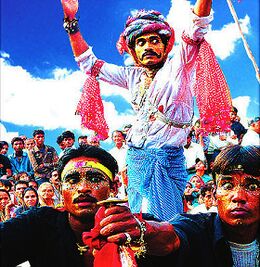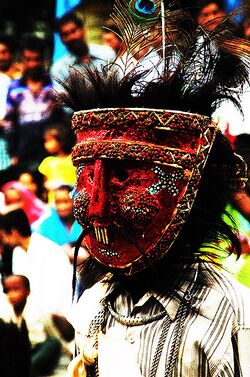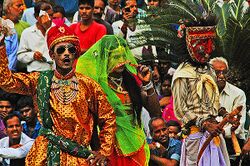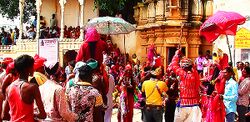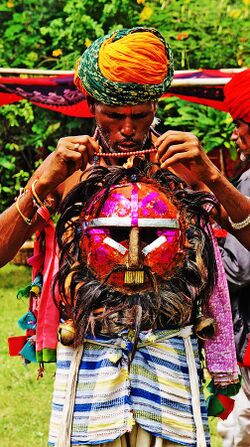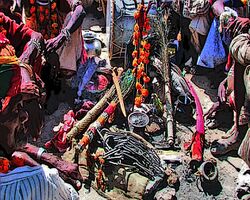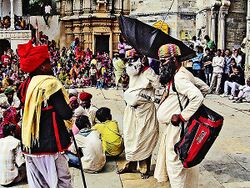Gavari
Topic: Social
 From HandWiki - Reading time: 10 min
From HandWiki - Reading time: 10 min
Gavari, also spelt Gavri,[1] is a 40-day long festival celebrated in July and September of each year in the Mewar region of Rajasthan, India .[2]
The Gavari season
Each year, bhopa shamans from Mewar's Bhil communities petition the Goddess to permit their villagers to perform the Gavari ritual and to accompany them for the weeks of touring. The average wait time for her consent is about 4–5 years, and once the ritual cycle begins, she must also be successfully invoked before each daily ceremony. Only when she visibly possesses one or more troupe members can the dance dramas begin and the ritual proceed.
Each of the 25-25 participating communities forms and dispatches its own Gavari company of 20-80 members. The troupes crisscross Mewar performing more than 600 day-long village ceremonies in all. In total, Gavari troupes in total can play to over a quarter of a million people annually.
During the 40-day Gavari season, all players practice strict austerities to maintain reverent contact with the living earth and the immanent spirit.[3] They avoid not only sex, alcohol and meat but also shoes, beds, bathing, and eating greens (which might harm insect life). They eat only a single meal each day during the season.[4][5]
In the final days, each troupe returns to its home village for a last performance and closing ceremonies. The cycle ends with an immersion rite to return the Goddess's fertility to their waters and all night raucous celebrations.
Dramas
A Gavari troupe repertoire may include 10-15 classic traditional tales and new ones are still evolving, but the overarching themes are the sacredness of the natural world, radical human equality, and the feminine nature of the divine. These values are reflected in traditional Bhil society where the environment is revered, hierarchy is abhorred, and women enjoy greater rights and status than in communities outside.[6][7]
Among Gavari's many mythic dramas, two of the most popular and often repeated are Badalya Hindawa (The Banyan Swing) and Bhilurana (King of the Bhils).
Badalya Hindawa recounts how the Goddess re-greened the Earth after a life-erasing flood and fiercely defends it thereafter from greed, stupidity and harm. The playlet features a powerful guru who loses his disciples beneath a sacred banyan tree and demands that the local king destroy it as an illicit source of power. The unnerved king complies and has the tree cut down. The Goddess and her devi sisters are outraged at this desecration and slip into his court disguised as acrobatic dancers to exact revenge. They lure the king close with their artistry, reveal their true nature, indict him for cowardice and sacrilege, and mortally terminate his reign.
Bhilurana is the tale of a composite leader representing five centuries of Bhil resistance to intrusions of all kinds. The play compresses and conflates the armed might of Turkic, Mughal and British invaders and depicts Goddess-inspired Bhil warriors finally driving them all away with daring ambushes, sabotage and shrewd guerrilla tactics.
Both plays end with celebration, salutations to the Goddess, and clear warnings to interlopers to never violate Nature or their sovereignty again.[8]
Gavari drama emphasis inspired improvisation over rehearsal and memorisation. The beginnings and ends of Gavari dramas are known, but how things transpire in between is highly mutable. There are no scripts and many players are illiterate farmers and labourers.[9] Individual plays can continue for hours, contain long soliloquies and dialogues, and are only performed by a particular troupe once on four or five years. This intuitive improvisational approach fosters great creative diversity and different villages may present the same stories in many very different ways. Players strive to perform in a receptive trance known as bhava, which resembles the fluid creative state that musicians and athletes call "flow" or "the zone".
Characters
Depending on the day and the plays selected a single Gavari troupe can present dozens of different characters - goddess avatars, gods, demons, historical figures, sacred animals, corrupt officials, etc. The only constant roles, which exist outside the dramas, are the Budia figure, his twin Rai devi consorts and Kutkadia, the master of ceremonies.
Women are not allowed to tour as actors with the troupe due to the 4-5 day menstrual isolation Bhil women observe each month. Consequently, all female characters are portrayed by men.[8]
Budia embodies a powerful fusion of Shaivite and demonic energies and is a vital protective Gavari figure. He is distinguished by his dramatic horse hair-fringed mask, sacred staff and twin Rai consorts. In each day's Gavari ceremony the Budia character has three main duties: circling the arena during opening invocations in the opposite direction as the dancers to seal in and protect the energy field they are generating; patrolling the arena perimeter during dance drama sequences to prevent audience members from entering the players' area or shaman circle unless they are clearly entranced; and periodically holding court at the arena's edge with his Rai escorts to accept offerings on behalf of the troupe and confer blessings.[10]
Every Gavari village has its own iconic Budia mask, which is treated as a sacred object and often handed down for generations.
Origin
There are many speculative theories about Gavari's genesis, but its true age and origin are unknown.
According to one hypothesis, it may have begun in rural Mewar at the end of the 16th century, when Mewaris largely regained control of their lands and lives from the Mughals in 1579,[11][12] the Rajput court gratefully awarded their mountain-dwelling Bhil brethren both unprecedented recognition and vast tracts of fertile agricultural land. The latter boon gradually drew most Bhils out of their forest encampments and began their transition to village agriculture. The 16th century hypothesis thus holds that this settling down of a semi-nomadic people created a nostalgia for their more adventurous heritage. Others assert that Gavari began in the 3rd or 4th century in Gujarat,[13] and still others that it as old as Bhil culture itself and dates back four millennia.[14][15][16]
Religious and shamanic aspects
Invocations
Gavari troupes perform two distinct invocation rituals. The first is used to ask the Goddess to permit a village to perform the Gavari cycle. This invocation is held in every Mewari Bhil community on or shortly before the full moon in the Hindu month of Shravana, which usually falls in August as the monsoon planting season ends.
The second is to confirm Her presence and participation at the start of each day's performance. Both invocations require incense, flowers. chanting, madal drum and thali cymbal music, a Shaivite trishula, and the kindling of a dhuni fire.
Initial sanction invocations are usually held in a darkened sanctuary attended by a small group of bhopa shamans, village elders and veteran Gavari players. Other villagers gather outside to await Her decision which is delivered by a possessed trembling bhopa.[17][18] He proceeds to channel Her spirit as She explains why She will or won't allow them to perform this year. Typical reasons for refusal include discord in the village, shrine disrepair, a poor monsoon, a crop blight, etc., which must be dealt with satisfactorily before petitioning Her again.[19]
Daily confirmation invocations are performed around an altar in the centre of the Gavari arena where shamans, musicians and senior players gather in a tight circle. The rest of the players and occasionally villagers dance counterclockwise around this core to create a welcoming energy field. A guardian Budia figure circles the dancers in the opposite direction to seal in their energy and protect it from misuse. The Goddess spirit's arrival and presence is signaled by one or more bhopas falling into trembling bhava trance.[20]
Other requisite ritual instruments used after Her manifestation include peacock feather sceptres to dramatize and distribute possession's quivering energetic power, and heavy saankal chains with which trance-elated participants often beat their backs.
Possession and trance
Successful invocations have several visible effects. First they connect the village shaman(s) to the Goddess spirit so they can audibly articulate Her concerns, requests and will.[1][21] Second, they infuse the Gavari players with creative inspiration to ably enact their roles. Finally, they can overwhelm some villagers with a sense of wonder, grace and bliss. Entranced villagers may be welcomed into the shaman circle or approached for healings and blessings by other members of the crowd. Those possessed often later report feelings of great exhilaration and selfless unity with all surrounding life. Such experiences reinforce Bhils' belief in Gavari's power, their own inalienable equality, and the sacredness of the natural world.
Social and cultural significance
In Gavari, the beauty and power of the natural world are the ultimate expression of divinity. Wilful or heedless damage to its diversity, health or future is thus regarded as not only short-sighted and suicidal, but also criminal and blasphemous.[22] Such views are the seed Seven generation sustainability among many indigenous tribes and their current widespread battles to safeguard water resources, endangered ecosystems and biocultural diversity.[23][24]
Gavari is righteously egalitarian and disrespectful of unjust authority.[25] Its dramas vividly depict and celebrate the dispatching of powerful officials, gurus and merchants either by the mocking scorn of villagers or the sword of the Goddess in a protective maternal rage. No authority figure is spared and some playlets happily lampoon kings, Hindu gods like Krishna, and even charlatan Bhopa shamans.[26][8] The healthy skepticism such skits reflected and encouraged in rural Mewar, along with other similar art forms/practices in the subcontinent helped birth India's 2005 Right to Information Act, which has been journalistically hailed as "the most significant change to Indian democracy since Independence" [27]
Gavari's itinerant format continues to closely network and promote solidarity among Mewar's scattered rural villages as well as their constituent castes and religious communities.[28] Its rich mythic and historical repertoire also helps keep tribal youth aware of their heritage.[3]
Gavari's comedic skits on farm finance, greedy middlemen and corrupt merchants offer villagers wry lessons in real world commerce and economic self-defense, especially with regard to crop brokers, moneylenders, credit scams, and urban conceptions of wealth.[19]
Gavari tightens inter-community bonds with its month of itinerant village visitations and solidifies Bhils’ sense of responsibility for a world far beyond their neighboring fields.[22] Although only Bhils play roles in the ceremony, Gavari performances also internally solidify communities by involving all castes, communities and age groups in the preparations and audience delight.[29]
Current status
The Gavari tradition at home has fallen on hard times[3] Rajasthan's government schools now forbid Bhil students to be truant to accompany their village Gavari troupes on their month-long pilgrimages. This alone is potentially lethal since Gavari has no scripts or schools and the only way to learn its ceremonies, arts and stories is as an apprentice participant. Add to this the accelerating exodus of working age youth to metro centers in search of employment and the average size and number of rural Gavari troupes continues decline.[30]
There are also positives. Local Bhil organizations are also becoming more active in promoting Gavari and its core values. The first English language introduction to Gavari is now available;[8] lobbying is underway for Sangeet Nakat Akademi and UNESCO recognition of Gavari as a globally significant Intangible Cultural Heritage treasure; an increasing number of Gavari clips are appearing on YouTube and Japanese scholars have initiated innovative economic studies of Gavari's societal benefits[31]
Udaipur's West Zone Cultural Centre has started presenting films and samples of Gavari artistry;[32] and local eco-festivals are also introducing the tradition to urban audiences.[33] In 2016 the Udaipur District Collector and Rajasthan Chief Minister Vasundhara Raje mobilized local agencies and NGOs to create "Rediscovering Gavari",[34] a multi-year program to promote "Gavari as an ancient folk art miracle... spiritually arousing, artistically surprising and historically mysterious."[35]
The Rediscovering Gavari program invited 12 rural troupes to perform the ceremony on different days in iconic Udaipur settings. These unprecedented events exposed thousands of tourists and townsfolk to Gavari for the first time and sparked a rare blaze of media attention.[13][36] This was followed by the first Gavari presentation in Delhi at the 2016 National Tribal Carnival, which was attended by Prime Minister Modi who offered lavish praise and encouragement.[37]
See also
- Folk religion
- Guerrilla theatre
- Indigenism
- Naturalistic pantheism
- Nature worship
- Rajasthani people
- Religious naturalism
References
- ↑ 1.0 1.1 Henderson, Carol (2002). Culture and customs of India. Westport, Conn.: Greenwood Press. pp. 141. ISBN 0313305137. OCLC 58471382.
- ↑ 3.0 3.1 3.2 Tribal dances of India. Tribhuwan, Robin D., Tribhuwan, Preeti R.. New Delhi: Discovery Pub. House. 1999. pp. 106. ISBN 8171414435. OCLC 41143548.
- ↑ "Keeping history alive dramatically". 27 September 2007. http://www.thehindu.com/todays-paper/tp-features/tp-fridayreview/keeping-history-alive-dramatically/article2273799.ece.
- ↑ "MaskIndia Bhil Gavri Gavari Dance – Chhoti Undri village Rajasthan: Ethnoflorence – Indian and Himalayan folk and tribal arts" (in fr). http://ethnoflorence.skynetblogs.be/mask-bhil-gavari-dance/.
- ↑ Mitra, Aparna (2008-06-01). "The status of women among the scheduled tribes in India". The Journal of Socio-Economics. Behavioral Dimensions of the Firm Special Issue 37 (3): 1202–1217. doi:10.1016/j.socec.2006.12.077.
- ↑ "Bhil tribal communities" (in en-US). http://www.indianmirror.com/tribes/bhiltribe.html.
- ↑ 8.0 8.1 8.2 8.3 Agneya, Harish (2014). Gavari - Mewar's electrifying tribal dance-drama: An Illustrated Introduction. India: Tuneer Films. pp. 24. ISBN 978-9352123292.
- ↑ "Bhils - Dictionary definition of Bhils | Encyclopedia.com" (in en). http://www.encyclopedia.com/humanities/encyclopedias-almanacs-transcripts-and-maps/bhils.
- ↑ "The Many Faces of Budia – Mewar Gavari" (in en-GB). http://www.gavari.info/gallery/the-many-faces-of-budia/.
- ↑ Chandra, Satish (2005). Medieval India : from Sultanat to the Mughals (Revised ed.). New Delhi: Har-Anand Publications. pp. 121–122. ISBN 8124110662. OCLC 469652456.
- ↑ "mughal-mewarconflict - airavat". https://sites.google.com/site/airavat/mughal-mewarconflict.
- ↑ 13.0 13.1 "Going global: Mewar's tribal folk opera 'Gavari' ready for international stage - Times of India". The Times of India. 2016-08-29. http://timesofindia.indiatimes.com/city/udaipur/Going-global-Mewars-tribal-folk-opera-Gavri-ready-for-international-stage/articleshow/53908600.cms.
- ↑ (in en) Rajasthan State Gazetteer: History and culture. Directorate, District Gazetteers, Government of Rajasthan. 1995. pp. 199, 205. https://books.google.com/books?id=ngZWAAAAYAAJ.
- ↑ Fairs and festivals of Indian tribes. Tribhuwan, Robin D.. New Delhi: Discovery Pub. House. 2003. pp. 57. ISBN 8171416403. OCLC 50712988.
- ↑ "Gavari – A Dance Drama of Bhils" (in en). UdaipurBlog. http://www.udaipurblog.com/gavari-a-dance-drama-of-bhils.html.
- ↑ Nayar, V. G.; Nayar, M. G. (2000) (in en). Encyclopaedia of Sociology of Religion: Sociology of religions in India. Cosmo Publications. pp. 161. ISBN 9788170209751. https://books.google.com/books?id=phRzAGYR9swC&dq=bhils+trance+invocatons&pg=PA161.
- ↑ Majhi, Anita Srivastava (2010). Tribal culture, continuity, and change : a study of Bhils in Rajasthan. New Delhi: Mittal Publications. pp. 63. ISBN 978-8183242981. OCLC 609982250.
- ↑ 19.0 19.1 "Gavari Introduction – Mewar Gavari" (in en-GB). http://www.gavari.info/gavari-introduction/.
- ↑ "'Gavri' the Opera of Mewar" (in en-GB). UdaipurTimes.com. 2010-09-28. http://udaipurtimes.com/gavri-the-opera-of-mewar/.
- ↑ Brower, Barbara; Johnston, Barbara Rose (2016-09-17) (in en). Disappearing Peoples?: Indigenous Groups and Ethnic Minorities in South and Central Asia. Routledge. ISBN 9781315430393. https://books.google.com/books?id=hqwYDQAAQBAJ&dq=bhils+trance+invocations&pg=PT77.
- ↑ 22.0 22.1 "Mewar Gavari – Mewar's ecstatic tribal folk opera" (in en-GB). http://gavari.info.
- ↑ "11 Indigenous resistance movements you need to know | rabble.ca" (in en). 13 November 2014. http://rabble.ca/news/2014/11/11-indigenous-resistance-movements-you-need-to-know.
- ↑ "Year of Clout: 10 Stories of Indigenous Environmental Influence in 2015 - Indian Country Media Network" (in en-US). https://indiancountrymedianetwork.com/news/environment/year-of-clout-10-stories-of-indigenous-environmental-influence-in-2015/.
- ↑ Henderson, Carol E. (2002). Culture and customs of India. Westport, Conn.: Greenwood Press. pp. 156. ISBN 0313305137. OCLC 58471382.
- ↑ Chandalia, Hemendra Singh. "Tribal Dance-drama Gavari : Theatre of Subversion and Popular Faith" (in en). academia.edu. https://www.academia.edu/31877270. Retrieved 29 May 2022.
- ↑ "The invisible history of people's movements". The Telegraph. https://www.telegraphindia.com/1140313/jsp/opinion/story_18068459.jsp.
- ↑ South Asian folklore : an encyclopedia : Afghanistan, Bangladesh, India, Nepal, Pakistan, Sri Lanka. Claus, Peter J., Diamond, Sarah, 1966-, Mills, Margaret Ann.. New York: Routledge. 2003. pp. 239. ISBN 0415939194. OCLC 49276478.
- ↑ "Keeping history alive dramatically" (in en). The Hindu. http://www.thehindu.com/todays-paper/tp-features/tp-fridayreview/keeping-history-alive-dramatically/article2273799.ece.
- ↑ Majhi, Anita Srivastava (2010). Tribal culture, continuity, and change : a study of Bhils in Rajasthan. New Delhi: Mittal Publications. pp. 150. ISBN 978-8183242981. OCLC 609982250.
- ↑ "Creative Economy study on Mewar's Gavari tradition by Japanese Researchers | UdaipurTimes.com" (in en-GB). UdaipurTimes.com. 2016-09-19. http://udaipurtimes.com/gavari-traditions-interest-japanese/.
- ↑ "Aarnya Parva Enthralls Audiences - Event Review @ Creanara" (in en). http://www.creanara.com/reviews/events/aarnya-parva-enthralls-audiences.
- ↑ "Shakti Sunday resonates with World Music Day & honors Gavari tradition | UdaipurTimes.com" (in en-GB). UdaipurTimes.com. 2014-06-23. http://udaipurtimes.com/shakti-sunday-resonates-with-world-music-day-honors-gavari-tradition/.
- ↑ "Rediscovering Gavari – 2016 – Mewar Gavari" (in en-GB). http://www.gavari.info/rediscovering-gavari-2016/.
- ↑ "Administration will lay emphasis on Gavari festival. | Daily Udaipur" (in en-US). Daily Udaipur. 2016-08-04. http://www.dailyudaipur.com/administration-lay-emphasis-on-gavari-festival/.
- ↑ "Mewar's ecstatic tribal folk opera 'Gavri' seeks global recognition | Udaipur Kiran : Latest News Headlines, Current Live Breaking News from India & World" (in en-US). http://udaipurkiran.com/mewars-ecstatic-tribal-folk-opera-gavri-seeks-global-recognition/.
- ↑ "National tribal festival at new delhi, mewars gavri dance". http://m.rajasthanpatrika.patrika.com/story/udaipur/national-tribal-festival-at-new-delhi-mewar-s-gavri-dance-2362056.html.
External links
 |
 KSF
KSF